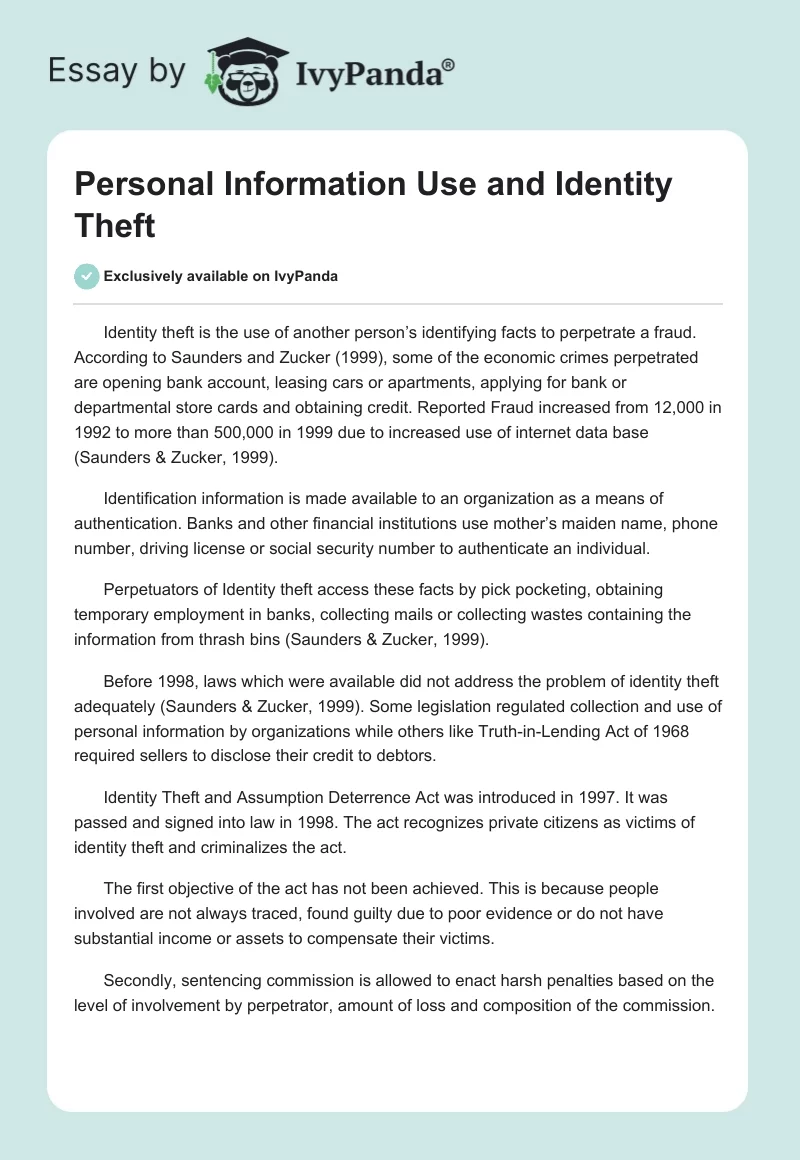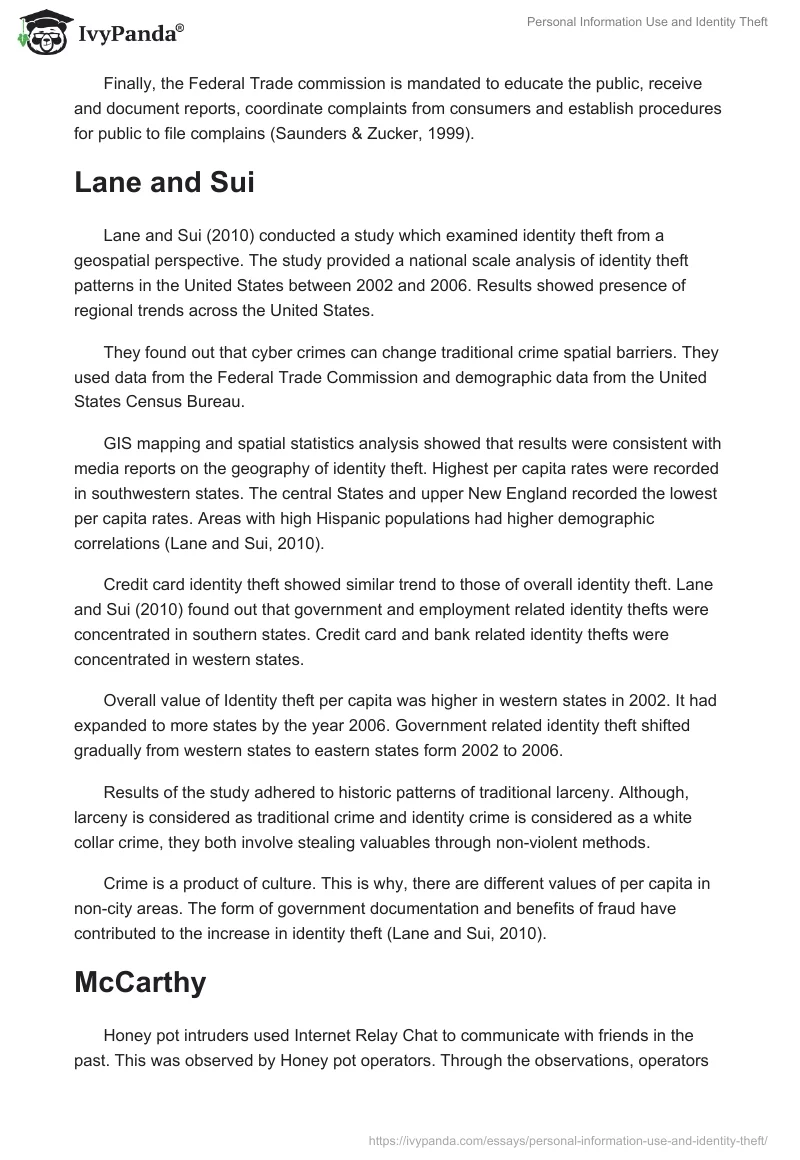Identity theft is the use of another person’s identifying facts to perpetrate a fraud. According to Saunders and Zucker (1999), some of the economic crimes perpetrated are opening bank account, leasing cars or apartments, applying for bank or departmental store cards and obtaining credit. Reported Fraud increased from 12,000 in 1992 to more than 500,000 in 1999 due to increased use of internet data base (Saunders & Zucker, 1999).
Identification information is made available to an organization as a means of authentication. Banks and other financial institutions use mother’s maiden name, phone number, driving license or social security number to authenticate an individual.
Perpetuators of Identity theft access these facts by pick pocketing, obtaining temporary employment in banks, collecting mails or collecting wastes containing the information from thrash bins (Saunders & Zucker, 1999).
Before 1998, laws which were available did not address the problem of identity theft adequately (Saunders & Zucker, 1999). Some legislation regulated collection and use of personal information by organizations while others like Truth-in-Lending Act of 1968 required sellers to disclose their credit to debtors.
Identity Theft and Assumption Deterrence Act was introduced in 1997. It was passed and signed into law in 1998. The act recognizes private citizens as victims of identity theft and criminalizes the act.
The first objective of the act has not been achieved. This is because people involved are not always traced, found guilty due to poor evidence or do not have substantial income or assets to compensate their victims.
Secondly, sentencing commission is allowed to enact harsh penalties based on the level of involvement by perpetrator, amount of loss and composition of the commission.
Finally, the Federal Trade commission is mandated to educate the public, receive and document reports, coordinate complaints from consumers and establish procedures for public to file complains (Saunders & Zucker, 1999).
Lane and Sui
Lane and Sui (2010) conducted a study which examined identity theft from a geospatial perspective. The study provided a national scale analysis of identity theft patterns in the United States between 2002 and 2006. Results showed presence of regional trends across the United States.
They found out that cyber crimes can change traditional crime spatial barriers. They used data from the Federal Trade Commission and demographic data from the United States Census Bureau.
GIS mapping and spatial statistics analysis showed that results were consistent with media reports on the geography of identity theft. Highest per capita rates were recorded in southwestern states. The central States and upper New England recorded the lowest per capita rates. Areas with high Hispanic populations had higher demographic correlations (Lane and Sui, 2010).
Credit card identity theft showed similar trend to those of overall identity theft. Lane and Sui (2010) found out that government and employment related identity thefts were concentrated in southern states. Credit card and bank related identity thefts were concentrated in western states.
Overall value of Identity theft per capita was higher in western states in 2002. It had expanded to more states by the year 2006. Government related identity theft shifted gradually from western states to eastern states form 2002 to 2006.
Results of the study adhered to historic patterns of traditional larceny. Although, larceny is considered as traditional crime and identity crime is considered as a white collar crime, they both involve stealing valuables through non-violent methods.
Crime is a product of culture. This is why, there are different values of per capita in non-city areas. The form of government documentation and benefits of fraud have contributed to the increase in identity theft (Lane and Sui, 2010).
McCarthy
Honey pot intruders used Internet Relay Chat to communicate with friends in the past. This was observed by Honey pot operators. Through the observations, operators knew when an intruder wanted to attack. Intruders used automated tools to access information about a group called black hats (McCarthy, 2003).
Since Honey pot was not instrumental in data capture, intruders could be observed through packet capture network tariff. After entering Honey pot, the intruders downloaded a collection of tools called Cywing from cywing.com.
They used the tools to conceal their identities and continue communicating using Internet Relay Chat. After monitoring IRC tariffs for sometimes, Honey pot operators realized that credit card information was being shared. Communication was taking place between a software and a human being.
In 2003, DALnet banned listing channels because of shared information. Owners of such fraudulent websites used stolen credit card information to pay service providers.
They also applied some tactics after their fraud was discovered. They were sometimes taken offline forcing them to relocate. Researchers downloaded and studied the “bot” used from one site. It contained a Trojan Horse which attempted to compromise computer and install remote program to be used for control.
Human to human communication was also observed (McCarthy, 2003). They made announcements online. It was also noticed that not all credit cards information came from computers.
Channels conveyed messages to carders working at banks, hotels and restaurants who sell credit cards. People purchased such information with as little as $10. Communities inhibiting IRC and other websites do not portray themselves as criminals (McCarthy, 2003).
Works Cited
Lane, Gina W., and Daniel, Z. Sui. “Geographies of identity theft in the U.S.: understanding spatial and demographic patterns in 2002–2006.” GeoJournal (2010): Web.
McCarthy, Bill. Automated Identity theft. Azusa Pacific University, 2003. Web.
Saunders, Kurt M., and Bruce Zucker. “Countering Identity Fraud in the Information Age: The identity Theft and Assumption Deterrence Act.” International Review of Law Computers 13.2 (1999): 183-193. Print.


